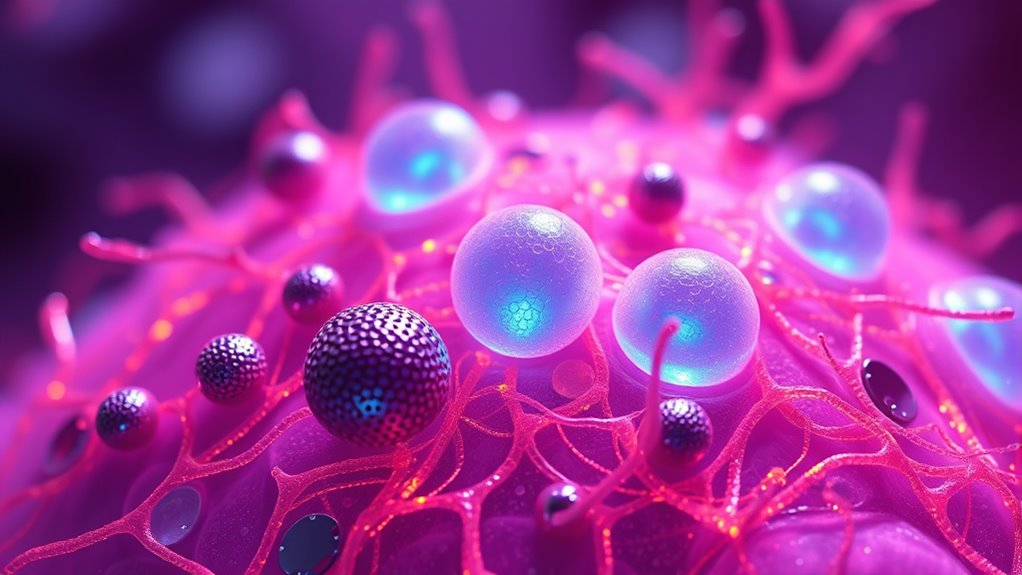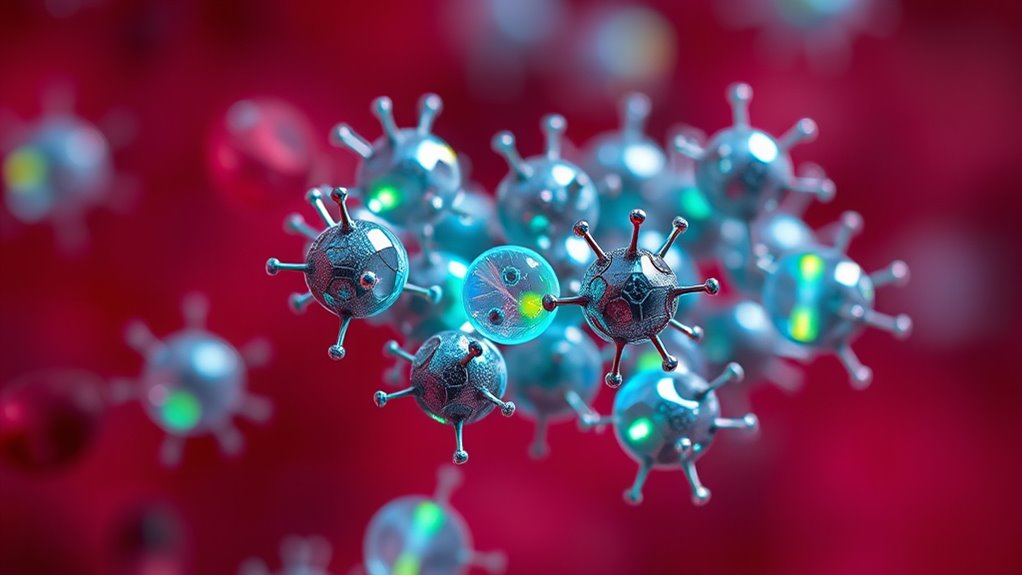Nanobots in targeted cancer therapy are tiny, smart devices designed to locate and destroy cancer cells precisely, minimizing damage to healthy tissue. They can navigate your bloodstream, deliver drugs, and be controlled remotely using magnetic fields or light. While they hold great promise for safer, more effective treatments, ethical and safety concerns need careful attention. To see how these innovations could impact your future health options, discover the ongoing developments and challenges in this exciting field.
Key Takeaways
- Nanobots can precisely target and destroy cancer cells, minimizing damage to healthy tissue.
- They are designed with biocompatible materials to ensure safety and reduce immune rejection.
- External controls like magnetic fields or light allow real-time navigation and treatment adjustments.
- Ethical considerations include safety, long-term effects, and preventing misuse or unintended targeting.
- Responsible regulation and transparency are essential for integrating nanobots into mainstream cancer therapy.

Nanobots are revolutionizing cancer therapy by offering targeted, minimally invasive treatment options. These tiny robots can navigate through the bloodstream to locate and destroy cancer cells with remarkable precision. Central to their effectiveness is nanobot design, which involves engineering these microscopic devices to perform specific tasks safely and efficiently. When designing nanobots, scientists focus on creating structures that can recognize cancer cells, deliver therapeutic agents directly to tumors, and avoid healthy tissue. They incorporate biocompatible materials to prevent immune rejection and guarantee they can operate within the body without causing harm. The design process also emphasizes the ability to control and monitor nanobots remotely, often through external magnetic fields or light, enabling real-time adjustments during treatment. As you explore nanobot design, you’ll find that every detail—from size and shape to surface functionality—is tailored to maximize targeting accuracy and minimize side effects. Additionally, understanding projector technology can provide insights into how precision and control are achieved in other advanced systems.
However, with this technological advance come important ethical considerations. Developing nanobots raises questions about safety, long-term effects, and potential misuse. Since these devices are so small and capable of traversing the body’s complex systems, you need to contemplate what happens if they malfunction or accidentally target healthy cells. Researchers debate how to establish robust safety protocols and regulatory frameworks to prevent unintended consequences. Ethical concerns also extend to patient consent and privacy; you must guarantee patients fully understand the risks and benefits of nanobot-based therapies. Furthermore, the potential for dual-use technology—where nanobots could be used for harmful purposes—adds another layer of complexity. As you work in this field, you’re responsible for balancing the promise of groundbreaking cancer treatments with these moral and societal challenges. Developing standards and guidelines for responsible research and application becomes essential to guarantee that nanobots serve humanity positively.
In addition, you’ll want to think about the broader implications of deploying nanobots in medicine. Transparency about their capabilities, limitations, and risks helps foster public trust. Ongoing dialogue among scientists, ethicists, regulators, and patients is vital to navigate these issues effectively. While nanobot design aims for precision and safety, addressing ethical considerations guarantees that innovation doesn’t outpace responsible use. As you continue to develop nanobots for cancer therapy, your goal should be to harness their potential while respecting moral boundaries and prioritizing patient well-being. This balance will be key to integrating nanobots into mainstream medicine and turning the promise of targeted, minimally invasive cancer treatment into a widespread reality.
Frequently Asked Questions
How Are Nanobots Powered Inside the Human Body?
You might wonder how nanobots get powered inside your body. They typically use wireless energy transfer, where energy is transmitted through electromagnetic signals, eliminating the need for batteries. These nanobots are made from biocompatible materials, ensuring they don’t harm your tissues. This wireless energy system allows nanobots to operate efficiently and safely, enabling precise tasks like targeted cancer therapy without invasive procedures.
What Are Potential Risks of Using Nanobots for Therapy?
You should be aware that using nanobots for therapy presents biosafety concerns, like unintended interactions with healthy cells or immune reactions. Ethical considerations also come into play, such as privacy issues and long-term effects. These risks could lead to unforeseen health problems or ethical dilemmas about human enhancement. It’s vital to carefully evaluate these factors before widespread adoption to guarantee patient safety and societal acceptance.
Can Nanobots Target Specific Cancer Cell Types?
Yes, nanobots can achieve precision targeting and cell specificity, allowing you to direct them precisely to specific cancer cell types. They are designed to recognize unique markers on cancer cells, enabling them to distinguish between healthy and malignant cells. This targeted approach helps minimize side effects and increases treatment effectiveness. With advanced engineering, nanobots can navigate the body intelligently, ensuring they reach only the intended cancer cells for ideal therapy.
How Are Nanobots Cleared From the Body After Treatment?
After treatment, nanobots are cleared from your body mainly through biodegradation and body clearance pathways. Your body breaks down nanobots via nanobot biodegradation, where enzymes or environmental conditions disassemble them into harmless components. These fragments then follow natural body clearance pathways, such as the liver and kidneys, to be eliminated through urine or feces. This process guarantees the nanobots don’t accumulate and helps maintain your health after therapy.
What Regulatory Approvals Are Needed for Clinical Use?
You need to navigate regulatory pathways like FDA approval or equivalent agencies, which evaluate safety, efficacy, and manufacturing quality. You’ll have to meet approval criteria such as demonstrating clinical benefits and minimal risks. This process involves submitting detailed data from preclinical and clinical trials, ensuring your nanobots comply with standards for medical devices or drugs. Securing these approvals is essential before your nanobots can be used for targeted cancer therapy in patients.
Conclusion
You can see how nanobots revolutionize cancer treatment, offering precision like never before. Imagine reducing side effects by up to 80%, as studies suggest, thanks to their targeted approach. This means fewer healthy cells suffer during therapy, and your recovery could be faster. With such promising stats, nanobots are shaping a future where cancer treatment is more effective, less invasive, and tailored just for you. The potential is truly groundbreaking—you’re on the brink of a new medical era.









